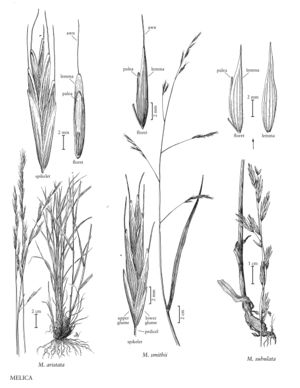Difference between revisions of "Melica subulata"
FNA>Volume Importer |
FNA>Volume Importer |
||
| Line 8: | Line 8: | ||
|name=Melica subulata var. pammelii | |name=Melica subulata var. pammelii | ||
|authority=unknown | |authority=unknown | ||
| − | }}{{Treatment/ID/Synonym | + | }} {{Treatment/ID/Synonym |
|name=Bromelica subulata | |name=Bromelica subulata | ||
|authority=unknown | |authority=unknown | ||
| Line 23: | Line 23: | ||
-->{{Treatment/Body | -->{{Treatment/Body | ||
|distribution=Alaska;Colo.;Idaho;Nev.;S.Dak.;Wash.;Wyo.;Alta.;B.C.;Mont.;Calif.;Oreg. | |distribution=Alaska;Colo.;Idaho;Nev.;S.Dak.;Wash.;Wyo.;Alta.;B.C.;Mont.;Calif.;Oreg. | ||
| − | |discussion=<p>Melica subulata grows from sea level to 2300 m in mesic, shady woods. Its range extends from the Aleutian Islands of Alaska through British Columbia to California, east to Lawrence County, South Dakota, and into Colorado.</p> | + | |discussion=<p><i>Melica subulata</i> grows from sea level to 2300 m in mesic, shady woods. Its range extends from the Aleutian Islands of Alaska through British Columbia to California, east to Lawrence County, South Dakota, and into Colorado.</p> |
|tables= | |tables= | ||
|references= | |references= | ||
| Line 44: | Line 44: | ||
|publication year= | |publication year= | ||
|special status= | |special status= | ||
| − | |source xml=https://jpend@bitbucket.org/aafc-mbb/fna-data-curation.git/src/ | + | |source xml=https://jpend@bitbucket.org/aafc-mbb/fna-data-curation.git/src/8f726806613d60c220dc4493de13607dd3150896/coarse_grained_fna_xml/V24/V24_118.xml |
|subfamily=Poaceae subfam. Pooideae | |subfamily=Poaceae subfam. Pooideae | ||
|tribe=Poaceae tribe Meliceae | |tribe=Poaceae tribe Meliceae | ||
Revision as of 16:17, 18 September 2019
Plants cespitose, rhizomatous. Culms 55-125 cm, forming corms, corms attached to the rhizomes; internodes scabridulous basally. Sheaths usually scabridulous, sometimes glabrous or pilose; ligules 0.4-5 mm, to 1.5 mm on the lower leaves, to 5 mm on the upper leaves; blades 2-10 mm wide, abaxial surfaces smooth or scabridulous, adaxial surfaces scabridulous, glabrous or with hairs. Panicles 8-25 cm, lax; branches 1.7-9 cm, usually appressed to ascending, occasionally divergent, with 1-5 spikelets; pedicels not sharply bent; disarticulation above the glumes. Spikelets 10-28 mm, with 2-5 bisexual florets; rachilla internodes 1.8-2 mm. Lower glumes 4-8 mm long, 1.3-2.2 mm wide, 1-3-veined; upper glumes 5.5-11.5 mm long, 2-3 mm wide, 3-5-veined; lemmas 5.5-18 mm, usually strigose over the veins, hairs longest towards the base, 7-9-veined, veins prominent, apices strongly tapering and acuminate, unawned; paleas 1/2 - 3/4 the length of the lemmas; anthers 1.5-2.5 mm; rudiments 4-9 mm, tapering, resembling the bisexual florets. Caryopses 4-5 mm. 2n = 18.
Distribution
Alaska, Colo., Idaho, Nev., S.Dak., Wash., Wyo., Alta., B.C., Mont., Calif., Oreg.
Discussion
Melica subulata grows from sea level to 2300 m in mesic, shady woods. Its range extends from the Aleutian Islands of Alaska through British Columbia to California, east to Lawrence County, South Dakota, and into Colorado.
Selected References
None.
